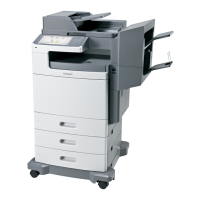Lexmark C792/X792 Color Product Study Guide Rev 2.1
For Training Purposes Only 6/24/2011
14
Theory of Operation
Electrophotographic Process
This color laser printer uses the Electrophotographic process (EP Process) to image toner onto the media
via a tandem (in-line) system. This system contains four color cartridge assemblies (cyan, yellow,
magenta, and black). The Electrophotographic Process steps are as follows:
• Charge – the Photoconductor Drum surface is evenly charged with electricity from the
Charge Roll (located inside the toner cartridge assembly) by the HVPS board,
• Expose – the Printhead (laser) exposes the photoconductor with light and creates a Latent
Image on the surface by partially discharging the area exposed. In this printer, One printhead
generates four separate beams to expose the four color stations,
• Develop – toner from the Developer Roll (located in the toner cartridge assembly) adheres to
the latent image on the surface of the photoconductor. This happens because of a difference
in charge potential between the two surfaces,
• 1
st
Transfer – an electrical charge is sent to each of the four 1
st
Transfer Rolls inside the ITU
(Transfer Belt). Due to the difference in charge potential, toner is transferred from the
Photoconductor Drum to the surface of the ITU as it passes each color station,
• 2
nd
Transfer – media is picked from the tray and passes between the 2
nd
Transfer Roller and
ITU surface. A positive charge is sent to the 2
nd
Transfer roller and toner jumps to the media
due to the charge difference,
• Fuse – the media is carried to the fuser where the toner it is bonded permanently to the
page by heat and pressure,
• Clean/Erase – a cleaning blade for each Photoconductor Drum and one for the ITU clean
residual toner from the surfaces of those components. Waste toner is deposited into the
Waste Toner Assembly. This printer does not have erase lamps.
If a component fails, it is important to recognize at which step the failure took place. By knowing this, you
can determine the source of the problem. Understanding the EP Process is the key to troubleshooting
print quality problems.
The page illustrates the EP Components in a cross-sectional of a C792x printer. The X792 printer has
the same EP components as the C792 printer.

